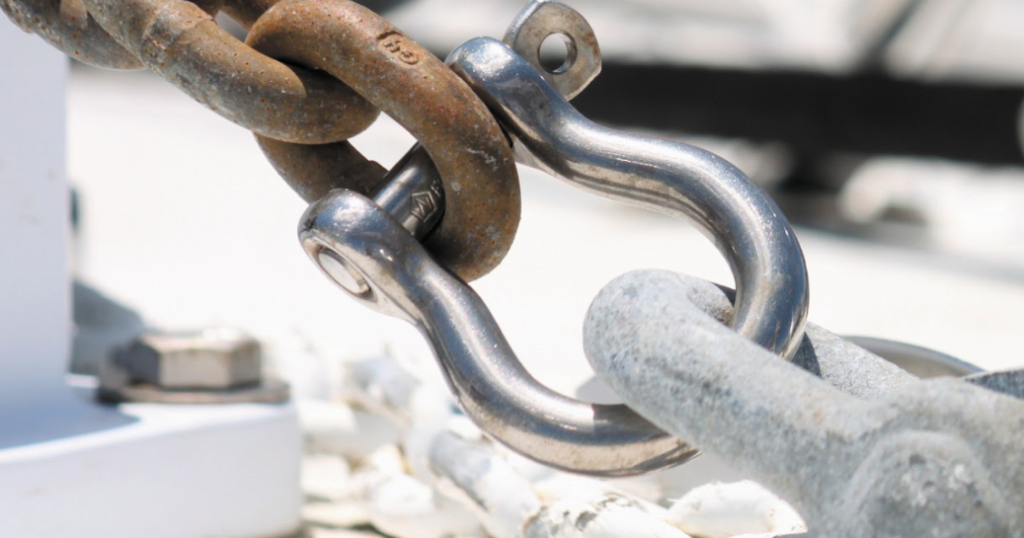
A rigging shackle is a type of hardware used to connect two objects together. It is typically used to connect rope, cable, or chain to a structure, such as a crane or other lifting device. The shackle is designed to be strong enough to handle the load being lifted and to resist the force of the pull or tension.
Rigging shackles come in a variety of sizes and shapes and are made from materials such as steel, stainless steel, and aluminum. They can be used in a variety of applications, such as for lifting, rigging, and attaching. They are often used in the construction and shipping industries.
The most important thing to consider when using rigging shackles is to make sure they are properly rated for the job they are being used for. This means making sure the shackle is rated to handle the amount of load being lifted, as well as the tension is applied.
In addition to making sure the shackle is rated properly, it is also important to inspect the shackle regularly for any signs of wear or damage. This includes checking for cracks, corrosion, or any other signs of damage that could compromise the strength of the shackle.
Rigging shackles are an important tool for a variety of jobs and industries. By understanding what they are, their purpose, and how to properly use them, you can ensure that your job is done safely and correctly.
What is Rigging Shackle?
Rigging shackles are pieces of hardware used to securely attach two objects together. They are commonly used to attach rope, cable, or chain to a structure such as a crane or other lifting device. Rigging shackles come in a variety of sizes and shapes and are typically made from steel, stainless steel, or aluminum. Rigging shackles are used in a variety of applications such as lifting, rigging, and attaching. They are often found in the construction and shipping industries.
What Does Rigging Shackle Mean For You?
Rigging shackles are an important tool for a variety of jobs and industries. By understanding what they are, their purpose, and how to properly use them, you can ensure that your job is done safely and correctly. It is important to ensure that rigging shackles are properly rated for the job they are being used for and to inspect them regularly for any signs of wear or damage. This can help to ensure the safety of the workers and the stability of the structure.
Rigging shackles can have a significant impact on the safety of a boat.
When using rigging shackles on a boat, it is important to ensure they are properly rated for the job they are being used for. In addition, it is important to inspect them regularly for any signs of wear or damage. This can help to ensure the safety of the boat and the stability of the structure.
Rigging shackles can also be used for a variety of other applications, such as hanging signs or banners, suspending loads, and more. No matter what the application, it is important to understand the purpose of the shackle and to ensure it is properly rated and inspected regularly.
The History of Rigging Shackles:
Rigging shackles have been used for centuries. They were first used in the 16th century by sailors and fishermen. They were used to secure the sails of ships and boats, as well as to attach lines to structures on the boat.
Today, rigging shackles are used in a variety of industries, from construction to shipping. They are designed to be strong enough to handle the load being lifted and to resist the force of the pull or tension. By understanding what they are, their purpose, and how to properly use them, you can ensure that your job is done safely and correctly.
What are some common uses for rigging shackles?
Common uses for rigging shackles include connecting rope, cable, or chain to a structure, such as a crane or other lifting device; suspending loads; hanging signs or banners; and more. They are often used in the construction and shipping industries and can be used in a variety of applications.
When using rigging shackles, it is important to ensure they are properly rated for the job they are being used for and to inspect them regularly for any signs of wear or damage. This can help to ensure the safety of the workers and the stability of the structure.
What are the potential consequences of using rigging shackles incorrectly?
Using rigging shackles incorrectly can have potentially serious consequences. If the shackle is not rated properly for the job it is being used for, it can fail, leading to accidents or injuries. In addition, if the shackle is not inspected regularly for any signs of wear or damage, it can cause the structure to be unstable or the load to be unevenly distributed, which can lead to serious accidents. It is important to understand the purpose of the shackle and to ensure it is properly rated and inspected regularly.
Conclusion: Rigging shackles can have a significant impact on the safety of a boat, and understanding
their purpose can help avoid common problems. By understanding what rigging shackles are, their purpose, and how to properly use them, you can ensure that your job is done safely and correctly. It is important to ensure that rigging shackles are properly rated for the job they are being used for and to inspect them regularly for any signs of wear or damage. This can help to ensure the safety of the workers and the stability of the structure.